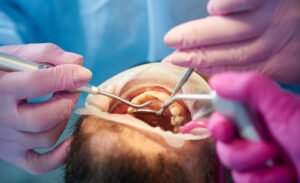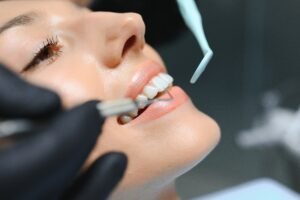When you’re met with the sudden, startling experience of a Cracked or Broken Teeth, panic might be your first reaction. However, understanding the necessary actions can help you transform that panic into prompt, decisive action. It’s important to remember that a Dental Emergency of Cracked Teeth such as this can significantly affect your oral health and overall well-being.
Dental emergencies often strike without warning, wreaking havoc on our comfort and peace of mind. A broken or cracked tooth, in particular, can be excruciatingly painful, prompting a quick visit to the dentist.
Dentists are skilled professionals trained to manage such emergencies efficiently and quickly. Here are five prompt dental actions dentists take during an emergency involving cracked or broken teeth.
In this blog post, we will discuss prompt actions you should take in the event of a dental emergency involving cracked or broken teeth.
Step 1: Pain Management
One of the immediate actions that a dentist takes when confronted with a dental emergency involving cracked or broken teeth is managing the patient’s pain. Intense discomfort is often the chief complaint of these injuries.
Must Read: Why Teeth Cleanings Matter: Your Calgary Guide to Smile Health
Upon arrival at our Calgary emergency dental center, the dentist promptly assesses the pain’s severity and source. Oral analgesics or local anesthesia numb the affected area, providing instant relief and allowing the dentist to proceed with further treatment.
Step 2: Thorough Examination
The next step is a comprehensive oral cavity examination focusing on the damaged tooth or teeth. The dentist uses various diagnostic tools, including dental mirrors, high-resolution intraoral cameras, and radiographs (X-rays). X-ray imaging is crucial to visualize the extent of the damage that may not be apparent to the naked eye. Such as fractures extending into the root or possible damage to the underlying bone.
Read More: Dental Do’s and Don’ts: Navigating 10 Everyday Oral Hygiene Tips For Better Health
The dentist assesses the depth and pattern of the crack or break, looking for signs of pulp exposure (the tooth’s living tissue). Which can make the tooth more susceptible to infection. The dentist will likely recommend the right dental treatment if pulp exposure or a severe crack extends beneath the gum line.
Step 3: Debris Removal and Tooth Stabilization
If debris in the area results from the injury (like fragments of the broken tooth or external debris), the dentist will carefully remove it. Removing debris is critical to prevent infection and ensure that the healing process starts effectively.
Check About: 10 Expert Tips to Counter Cavities: Prevention, Treatment, and Care
The dentist may use a dental splint to stabilize a severely cracked or broken tooth. This involves bonding a splinting material to the affected tooth and adjacent teeth to keep it from moving. Which can help to alleviate discomfort and prevent further damage. If necessary, a temporary filling material might be used to cover the damaged part of the tooth and protect it from sensitivity and potential infection.
Step 4: Treatment Plan Formulation
After the examination and preliminary treatments, the dentist will discuss the treatment options with the patient. The extent and nature of the crack or break will largely determine the recommended treatment.
A minor crack might only require a filling or bonding, where a tooth-colored resin seals the crack. Getting a dental crown in Calgary might be the best option if a significant part of the tooth is broken off but the tooth’s roots are healthy. However, for cracks that extend into the pulp, a root canal treatment might be necessary to remove the damaged pulp and seal the tooth. In the worst-case scenario, tooth extraction may be recommended if the tooth is severely broken and cannot be salvaged.
Know More: Say Goodbye to Bad Breath: 10 Effective Cures
Step 5: Post-treatment Care and Follow-up
Once the immediate treatment has been administered. The dentist will provide instructions for post-treatment care to ensure proper healing and recovery. This might include advice on oral hygiene, pain management, and dietary modifications. For instance, avoiding certain hard or chewy foods can help prevent further damage to the injured tooth.
Furthermore, the dentist will schedule follow-up appointments to monitor the healing process, carry out additional treatments (like placing a permanent crown after a root canal). Evaluate the need for further interventions, such as a dental implant in Calgary, if the tooth had to be extracted. These follow-ups prevent complications and restore full dental health and functionality.
Know More About: 10 Precautions to Take After A Root Canal Therapy
Conclusion
Depending on the severity of the situation, dentists may employ temporary solutions, such as dental cement. Or more extensive treatments like root canal therapy, crowns, or dental implants Calgary.
Dental professionals often educate their patients on the necessity of immediate attention to dental emergencies. Emphasizing the potential for more severe complications if left untreated. Regular check-ups and maintaining oral health can also help prevent such situations. Our dentists at The Port Dental Clinic in Calgary NE help you make informed decisions coupled with quick actions in case of emergencies.















